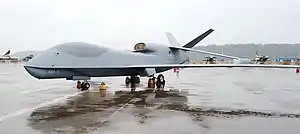Guizhou WZ-7 Soaring Dragon
The Guizhou WZ-7 Soaring Dragon (Chinese: 无侦-7 翔龙) is a high-altitude long endurance unmanned aerial vehicle (UAV) from the People's Republic of China.[1][3] The design uses a unique joined-wing design.[3]
| WZ-7 Soaring Dragon | |
|---|---|
 | |
| WZ-7 at Airshow China Zhuhai 2022 | |
| Role | Unmanned maritime surveillance and patrol aircraft |
| National origin | People's Republic of China |
| Manufacturer | Guizhou Aircraft Industry Corporation |
| Designer | Chengdu Aircraft Industry Group |
| Introduction | 2018[1] |
| Status | In production[1] |
| Primary users | People's Liberation Army Air Force People's Liberation Army Navy |
| Produced | 2015/2016 - ?[2] |
| Number built | 20 |
The primary mission is expected to be aerial reconnaissance, but it may also be fitted to provide targeting data for anti-ship ballistic missiles and cruise missiles.[4]
Development
The WZ-7 was designed by the Chengdu Aircraft Industry Group and constructed by the Guizhou Aircraft Industry Corporation. A model appeared at the 2006 China International Aviation & Aerospace Exhibition.[5] The first flight has not occurred as of 2011. The drone conducted radar cross-section testing.[5] The WZ-7 entered serial production in 2015 to 2016.[2] A complete redesign of WZ-7 was observed in 2020 with the Chinese Air Force roundel. The redesign featured V-tails, a different engine nozzle with the WS-13 turbofan engine, and changes to the ventral fin and the sail structure.[6] The WZ-7 UAV was officially unveiled by the military at the Zhuhai Airshow in 2021.[3][7] It was displayed again in 2022.[8]
Design
Larger than most UAVs, the WZ-7 features a tandem, joined-wing design, which allows for a more rigid, less flexible wing than other configurations, with benefits said to include an increased lift-to-drag ratio and less complex flight controls than a HALE UAV with a conventional wing would require.[9][5][4] The air intake for the engine is mounted atop the fuselage, with the engine itself mounted in the rear of the aircraft.[5] The prototype aircraft is powered by a Guizhou WP-13 turbojet engine, a copy of the Soviet Tumansky R-13; it is anticipated that an improved engine will be installed in production aircraft.[5][10]
The operational WZ-7 has a significantly modified shape. The single vertical tail on the prototype was changed to a pair of canted tails.[11] A turbofan engine was installed on the production model.[6] Due to the different engine and aerodynamics, the endurance of the production model is unknown. It is speculated to be longer than the 10 hours advertised for the prototype.[11]
Operational history
The WZ-7 entered service with the People's Liberation Army Air Force in 2018[1] and were spotted deployed to the Tibet Autonomous Region, Hainan Island and Yishuntun Airbase near North Korea.[12]
On 24 July 2019, a WZ-7 shadowed the American Ticonderoga-class cruiser USS Antietam which was transiting the Taiwan Strait.[13]
On 15 December 2022, it was reported that China has allegedly deployed WZ-7 UAVs near Indian border in Tibet.[14]
On 1 January 2023, a WZ-7 flew through the Miyako Strait into the Philippine Sea and returned to the East China Sea through the same route.[15][16]
Operators
- People's Liberation Army Air Force: 12 units as of 2022[17]
- People's Liberation Army Naval Air Force: 8 units as of 2018[18]
Specifications

Data from AirForces Monthly[5]
General characteristics
- Crew: None
- Length: 14.33 m (47 ft 0 in)
- Wingspan: 24.86 m (81 ft 7 in)
- Height: 5.41 m (17 ft 9 in)
- Powerplant: 1 × Guizhou WP-13 turbojet or unknown type of turbofan, 43.1 kN (9,700 lbf) thrust
Performance
- Cruise speed: 750 km/h (466 mph, 405 kn)
- Range: 7,000 km (4,300 mi, 3,800 nmi)
- Combat range: 2,000 km (1,200 mi, 1,100 nmi)
- Endurance: 10 hours (at maximum speed; with turbojet)
- Service ceiling: 18,000 m (59,000 ft)
- Thrust/weight: 5.8
See also
Aircraft of comparable role, configuration, and era
Related lists
References
- Rupprecht, Andreas; Dominguez, Gabriel (11 November 2021). "Chinese air force equips 16th Air Division with WZ-7 HALE UAVs". Janes. Retrieved 18 August 2022.
- Rupprecht, Andreas (2018). Modern Chinese Warplanes:Chinese Air Force - Aircraft and Units. Harpia Publishing. p. 106. ISBN 978-09973092-6-3.
- Waldron, Greg (29 September 2021). "Zhuhai UAV bazaar returns with a vengeance". FlightGlobal. Gale General OneFile. Retrieved 18 August 2022.
- Newdick, Thomas, ed. (September 2011). "World News: China's Soar Eagle UAV revealed". Combat Aircraft. Hersham, Surrey, UK: Ian Allan Publishing. 12 (9): 30. ISSN 2041-7489.
- Parsons, Gary, ed. (September 2011). "News Headlines: Has China Unveiled Its Soar Dragon?". AirForces Monthly. No. 282. London: Key Publishing. pp. 4–5.
- "Xianglong WZ-7 drone commissioned to guide carrier-killer missiles". China Arms. 18 December 2020.
- "New largest Chinese-made HALE combat drone WZ-7 Soar Dragon enters into service". armyrecognition. 11 November 2021.
- Trevithick, Joseph (7 November 2022). "All The Air Combat Developments Out Of China's Massive Air Show". The Drive.
- Yeo, Mike (30 September 2021). "Chinese airshow offers glimpse at military's new drones". Defense News.
- "Chinese UAV WZ-7 Soar Dragon conducts live combat training". airrecognition. 16 February 2022.
- Newdick, Thomas (3 January 2023). "Japanese Fighters Intercept China's High-Flying WZ-7 Drone For First Time". The Drive.
- "Soar Dragon UAVs Deploy to Yishuntun Airbase". Offiziere.ch. Bellingcat. 23 March 2018. Retrieved 2019-09-15.
- Axe, David (29 July 2019). "China's Giant Spy Drone Just Tailed a U.S. Navy Cruiser". The National Interest. Retrieved 2019-09-15.
- "China deploys Guizhou WZ-7 Soaring Dragon HALE drones at Shigatse Airport in Tibet near the border with India". 2022-12-15.
- "中国軍機の動向について" (PDF) (in Japanese). 2023-01-01.
- "Chinese drone spotted near southern Japanese islands". NHK World. 2023-01-02.
- The International Institute for Strategic Studies (15 February 2023). "6 Asia". The Military Balance 2023. London: Routledge. doi:10.4324/9781003400226. ISBN 9781003400226. S2CID 256916955.
- Rupprecht, Andreas (2018). Modern Chinese Warplane: Chinese Naval Aviation - Aircraft and Units. Harpia Publishing. p. 36. ISBN 978-09973092-5-6.